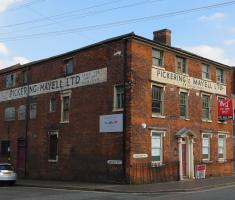
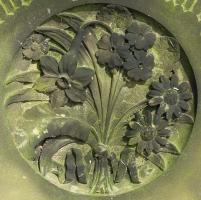
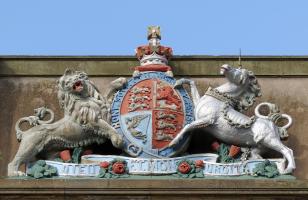
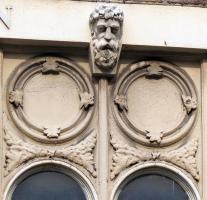
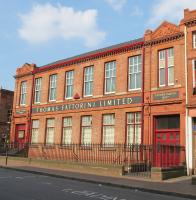
The Chamberlain Clock, at the junction of Warstone Lane with Vyse Street and Frederick Street, can be considered the natural centre of Birmingham’s Jewellery Quarter, and is of interest to these pages for the Victorian and Edwardian buildings and a bit of sculpture.
Chamberlain Clock, Birmingham, detail, and Joseph Chamberlain MP.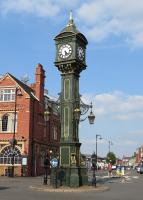
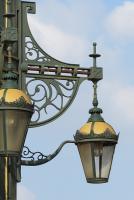

The Chamberlain Clock is one of those satisfyingly cast iron pieces – the style is more late Victorian than Edwardian – reminiscent of, though larger than, Little Ben, the clocktower which used to stand by Victoria Station in London before the endless rebuilding began. The sign says that the clock was put up in commemoration of the 1903 visit to South Africa by the Rt Hon J. Chamberlain MP, then Secretary of State for the Colonies. An interesting bit of Boer War memorabilia then.
The bank building on the corner of Warstone Lane and Vyse Street - HSBC today, previously a branch of the Midland Bank, and when it was built, in the 1900s, a branch of the Birmingham District and Counties Banking Company. It has sculpture around and above the entrance.
Birmingham District and Counties Banking Co building.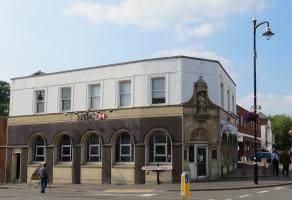
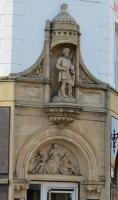
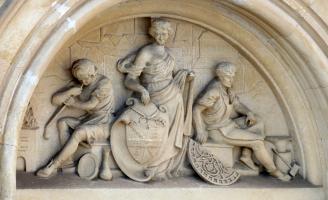
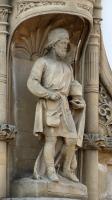
The sculpture consists of a group of three figures above the door in a semicircular pediment, and above this, a free-standing figure in a niche under a canopy. The group of three figures consists of a central standing female figure and two seated male ones. The standing female, wearing Classical drapes but with a decidedly Victorian hairstyle and anything but a Classical face, has one hand on the top of a cartouche-shaped shield, the other missing, but with a drape over the lower arm – she might perhaps represent Industry. On the left hand side is seated a glassblower, pipe to his mouth, an expanding semi-molten vessel on the other end, his furnace with now-closed muffle on the very edge of the frame. One foot is forward, the other rests on what is presumably a small bellows to increase the heat of the furnace, and in front of his stool rest a plate and a completed vessel (which in reality would probably not have been left to cool so fast but placed in a cool oven). On the other side, a man wearing an apron rests, in front of him a half-section of a clock dial, perhaps, or some other piece of ironware, and by him rests a large square-headed mallet in front of a small anvil on a stump. The low-relief carved background indicates the factories and chimneys of the area. The composition has the seated figures facing outwards rather than inwards, thus reducing the sense that they are subordinate to the standing female.
Above, the standing figure in the niche looks to be some historic merchant prince, with ringletted beard, wearing some turban-like headgear, and holding a casket or chalice in one hand; his other is empty, but a pouch hangs just beneath it at his belt, so we may envisage him reaching into that to take out some money. He is not really in the niche, which consists of a forward-reaching canopy and two side attached pillars, and as a result has been poorly protected from the weather, so that the stone is quite corroded and worn.
Just down Frederick St at the corner of Regent Street is the historic factory of Thomas Fattorini Ltd, badge and metal works and enamellists.
Warstone Road Cemetery: 1840s gatehouse, and monuments.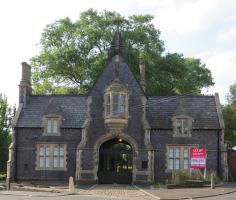
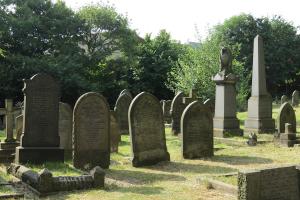
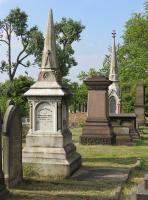
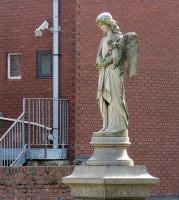
A few yards along Warstone Lane is the entrance to the Warstone Lane Cemetery (also called Brookfields or the Mint Cemetery), an ancient-looking, grey stone and slate gatehouse in Tudor style, put up in the late 1840s when the cemetery was opened. The burial ground stretches over some considerable area, and is pleasantly explorable by the casual visitor. In terms of sculptural interest, there are just a couple of full sized standing figures of angels, a couple more remnants of figures which have been ruined, the one to Walter John Overthrow (d.1932) looking to be a statue of the juvenile in school uniform. Several of the headstones contain carving in low relief, for example of flowers and corn, in the usual fashion, and there are also to be found a few tall obelisks and great tomb-chests in a harking back to 18th Century work. Near the entrance may also be found the World War I monument, in the form of a churchyard crucifix, and, completely unrelated to the interests of this website but extremely fascinating, the ‘War Stone’, which is a erratic boulder deposited by the retreating glacier during the ice age.
Birmingham pages // Sculpture in England
Visits to this page from 1 Mar 2016: 4,384